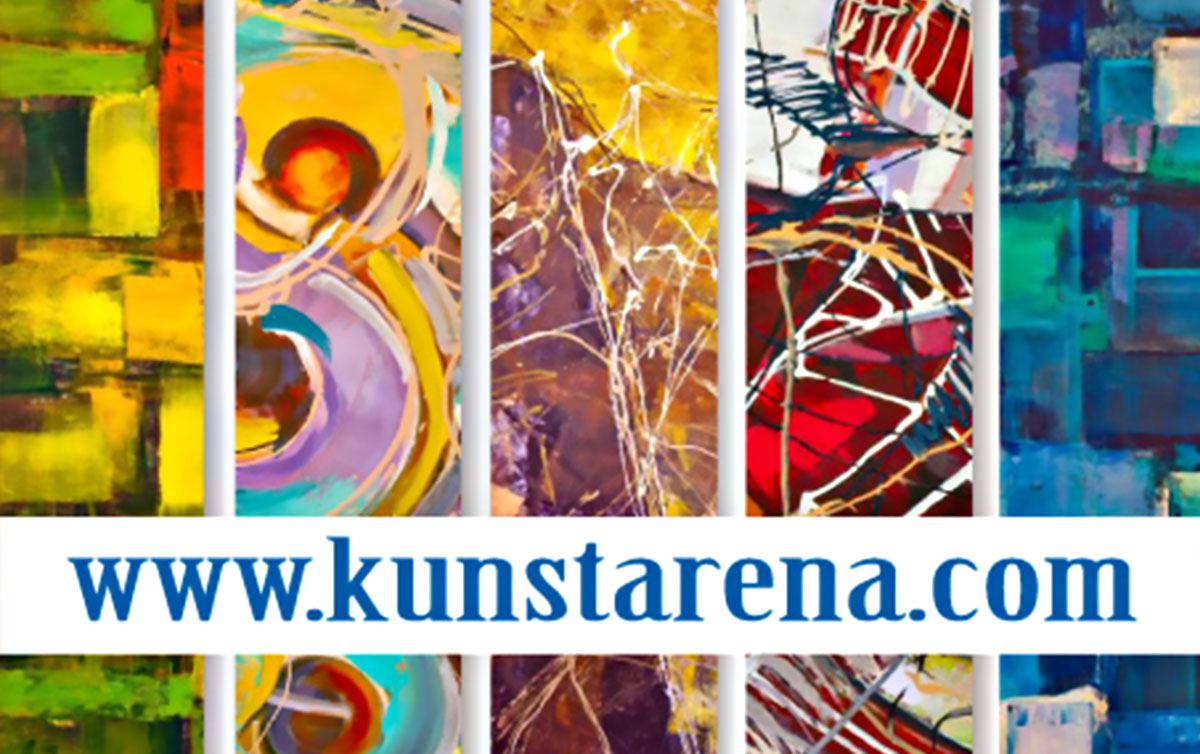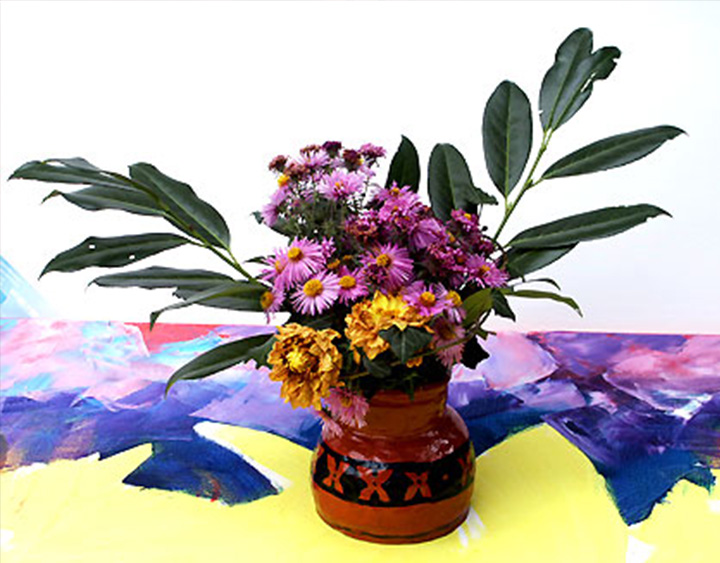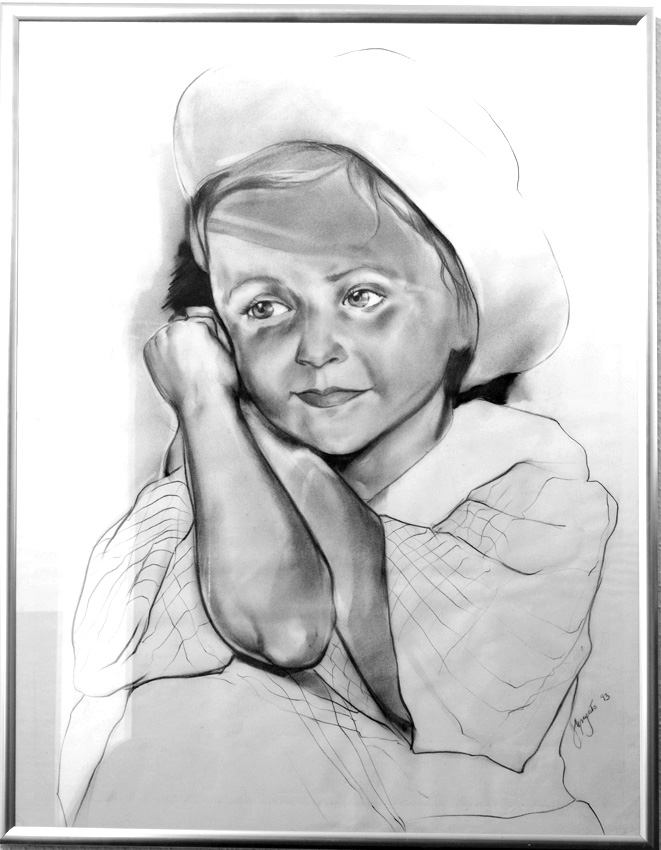During painting exercises, I observe a budding artist at work. “Well, what do you do now?” she asked me shyly. She would like to paint abstractly, but doesn’t know how to actually do it. We started drawing a picture together. Her brush movements struck me as uncertain. Trembling, she drew a line with a brush. She took too little paint on the brush and pressed the brush too hard on the canvas, resulting in jagged lines. “First, let’s start preparing the color palette,” I said optimistically. “When I start painting, I start preparing the colors in a plastic cup.
I choose the colors beforehand and thus determine the basic features of the color tones of a future picture. I prepare, generously, far more paint than I need for a single painting. Thanks to this preparation, I dip the brush in the paint as I need it at the moment. One time I dip the entire brush surface and another time just the edge of the brush. Depending on how the color is applied to the brush, I achieve different painting effects. In order to prevent the water-dilutable paints from drying in the following days, I cover the plastic cups with a lid and pour in a few drops of water beforehand.
While painting an abstract picture, I mix some of the prepared paints on a foil spread out on the table. Such a large painting palette is a dream for almost every painter.
How do I start painting the picture?
Most of the time I thought about what interests me at this point in time. From memory I get the pictures I have already painted, or the works of other artists that have left an impression on me. This is a quick thought, memory or glimpse floating in the mind as an inspirational image from the unknown. How do I start painting? I paint colored spots, areas first, and then add other parts of the painting.
The artist’s body movement as part of the paint tools.
While painting: Pay special attention to your body movement. You soon notice that our hands are an extended part of the brush. Our circular movements are determined by shoulder length and elbow joints. When painting spontaneously, I don’t care about the limitations of the body. In the depths of ourselves we already know what is possible and what is not. We just have to remember this inner “knowing”. After years of painting, I know which hand motion creates a certain type of line and which ones to use for appropriate desired effects.
In order to achieve an inner certainty of the desired movements in the application, various exercises can be used.
While listening to music, perform smooth brush strokes on an imaginary image. Through a kind of individual dance we awaken the intuitive body awareness, during which our body perception reaches the sufficient level for painting the complex picture. Very often I move painting tools in this learned rhythmically harmonious way and pay more attention to the movement itself, which is stored in my memory, than to the result achieved in the picture. In such moments I cannot see the picture to be painted properly because I am blinded by the concentration on experiencing the hand movement. Since I pay more attention to my awake intuition of movement than to my consciously rational decision, my pictures have gotten much better.
Our everyday life is a colorful space.
This time we are talking about painting, so colors will be our next topic.
Another exercise: – Playfully find the colors as a selective perception. It’s fun with the colors, listening to nature. In normal everyday life, we only observe the tones of nature when we are nosed at them, when we look for them directly. In everyday life, colors are taken for granted. For us, this means either being blinded by a choice, or letting ourselves naturally glide through a sea of colors like a sleepwalker.
To improve our knowledge of tones, we should avoid such an adjustment and keep an “eye” on the colors as often as possible. Only 10 minutes a day dedicated to the observation of the colors, after a year, develops in us a special sensitivity – a color memory. How can we keep our attention to color so that we don’t fall asleep in life and the colors fall back into the gray background of events?
Create a wonderful living space in your own colors, consciously surround yourself with “YOUR” shades. When the daily activities of habits overwhelm us, we don’t pay attention to our surroundings. Only in our free time do we observe our surroundings in a relaxed and conscious manner. We can use these very moments to creatively build our own color system.
Observing a bouquet of flowers, I see the colored patches and areas of leaves and flowers. Green leaves are visible on the sides and orange and purple in the center of the floral arrangement. “And now I only want to see green parts of the plant”, – I decide consciously. When asked to do so, everything that is “green” appears in my field of vision. Other colors disappear from my field of vision. Thanks to this phenomenon, which we have already practiced, we see a red traffic light at the intersection while driving, although in traffic we keep our gaze, our attention, on something completely different. Generally we see what we need, what we are trained to see, or what we want to see at the moment.
What we want happens. We just have to clearly express the desire and willingness to see what we want. Nothing is harder (than learning to consciously apply what you already know), right? Through this exercise of the imagination, I lose sight of other colors and can concentrate on desired nuances of certain color tones.
Often for fun, I walk around my studio and selectively “see” only one color. And now I just want to see red. Then what’s going on? Then my attention jumps to different places in the field of vision. A time back and forth until I notice all the red stuff and things. Other colors immediately disappear before my eyes, and at first only red wine appears in the field of vision. And there, and there, all of a sudden I just see the red things as if they’re highlighted from the bigger picture, scattered in the space in front of me.
Walking through the city or a large shopping mall, such exercises are a lot of fun. Desired colors in our field of vision block out the others and hide them in the shadows. Thanks to this ability of our mind, we can perceive our world selectively, emphasizing an infinite number of details without effort. What we need at the moment, or what we feel is important in our current life; it will be immediately highlighted and looked at by us.
Observe the proportions of things and the colour.
Let’s get back to painting again. When working with color, the level of difficulty increases compared to just drawing. One part is observing the shape of objects, for this we should also find a suitable color for them while painting.
In this case we put color in the found shapes. Experienced painters do it immediately without thinking about it. You draw the paint and “spill” the colors you want in the right places. You make the decisions immediately after the enjoyment that is to be evoked. Intuition tells them in good time where and how to do what. Some artists succeed in the intuitive implementation perfectly because they already know the entire cycle of painting from their own experience. Very often, to acquire such a skill, we separate drawing from painting, and we practice the two arts subjects separately.
In order to create an illusion of space in the picture, we most often use light and warm colors of the objects in the foreground. In an attempt to give spatial depth to figures in a flat picture, we surround them with dark and cool colors.
This is the easiest way to create depth in the image. Furthermore, the division the artist chooses narrows the observer’s focus into the image. Sharp outlines and fragments draw attention, and the blurred shapes complement a neutral space for the important formative parts of the image. Solids of color are a neutral (almost unnoticed) background. During active painting, I balance my gaze, often swaying, losing the depth of field of the eyes during the concentrated, immersed execution of the picture, and even losing the visibility (sight) of the eyes themselves. I see color as a living movement of creatures.
An additional Phantom game.
When we put imaginary hands into drawn objects, we start a new adventure in our imagination. The artist has an opportunity to wake up in his dream during his work. Dreams can be evoked by a very concentrated imagination that allows an artistic dream to be experienced lucidly. Intensive artistic work can even lead to creative visions and turn into an experienced walk between the painted “leaves”, in the middle of an imagined painting surface, in the imagination.
If it happens to you, don’t worry, camping in the illusionary worlds of painting has long been known and popular in art history. When something like this happens to you, don’t pay too much attention to the moving images of the imagination. Enjoy the individual experience. Vivid imaginations will always be a part of the creative process and dissolve when our interest in work wanes and we turn to everyday life.
Part 2. Paper – the bouquet.
When we begin to draw a bouquet of flowers as a still life, we first look at an imaginary point far behind our motif – in infinity somewhere in distant space.
What do we experience before we start drawing?
With the trick described above, we observe the arranged flowers, which initially appear blurred to us due to the defocused view. The intention behind this is that we allow ourselves to perceive the “general” form of our intention, the character and the overall composition that our “template” provides. We neglect the details at the beginning by placing the sharp focus of our gaze far behind what is in front of us. Thus aligned, we internally shift our attention between the different flat parts of the bouquet, while the focused gaze rests behind our subject in the distance.
It may seem like a tricky sensation that requires a little “self patience” to begin with. – We learn “to see” while we have been practicing “to look” for a long time. There’s nothing unusual about slipping back into a familiar habit. But now we should practice the new way of concentrating and slide back to the “blurred” observation.
We observe ourselves and notice that through practice, our attention changes to seeing our seemingly blurred visual image. – Instead of keeping the constant focus point behind the bouquet of flowers, out of habit, we begin to examine details of our still life. –
Well, right now, we are experiencing in practice the basics that practicing our attention in the landscape teaches us.
As we return to our subject, we sweep the sharp portion of our field of view well past the plane we wish to trace. In our visual image, the selected still life appears out of focus, without distracting details. We focus our attention on the surfaces that are reflected in us out of the blur. We emphasize the contours of the experienced areas with our attention and place them in an imaging sequence.
To begin with, we pay attention to the long contours that make our bouquet stand out from its background. The “longest contours” of the selected drawing motif run to the left and right of the still life, interrupted by protruding leaves and protruding stalks. We can perceive their place as divisions in the form seen against the background. In the spontaneous synthesis we see the first outer contour of the whole form and how it is interrupted by the shapes of the leaves and the lines of the grass. Which leaf stands out the most or shows the most intense color? – We begin to recognize individual groups of repetitive forms within the outer contour, from which our drawing motif is built. Individual details also stand out from these groups of forms, giving the observed bouquet its connected uniqueness. – With our calm attention, the structure of our following drawing begins to form itself in us.
What a relief that comes naturally from our nondescript landscape exercise. – We only find two different leaf surfaces and two types of flowers. We find that it is now easier to focus on the “dancing flowers”. We can easily turn to the details without being overwhelmed by their richness. – We continue to observe in order to recognize a little more inner order in the still-life dance that is spinning in front of us.
Arranged like “crumpled tissue paper”, the petals fall in curve with line in a repeating pattern. In our attention we have been waiting for this gift, for this simple form. It is quite sufficient to begin a drawing by remembering a simply generalized (recognized as universal) form that is easily transferred from attentive memory to paper.
With the memory awake in our attention, we turn to the white piece of paper and “jump” several times with the “blurred point of attention”, from the painting motif to the drawing paper. The outer contours of our motif show us a simple underlying form: an oval, square or rectangle, we transfer this first contour to the paper with our “seeing” until we “experience” it on the drawing ground. – It is like remembering a visual image. Our wish, which has been “sharpened” by the intensive attention, allows us to ask us to create an imaginary shadow image on the white sheet of paper. It appears by itself, blurry and quickly disappears before our “eyes” at the beginning of the exercise. When the perceived contour is already “fixed enough”, we can begin to move and center it with our intention on the drawing paper itself. It is optimal to first place the felt experience in the middle of the painting box.
Why are we doing this?
Just looking at the bouquet makes it seem to vibrate. – But it is we who awaken this restlessness in us of our own accord. We jump from one detail to the next with our eyes. The rest, the unnoticed part of the motif that is not in our visual image, falls back into the now unobserved blur and thus into inattention. Without a precise plan, we concentrate on small details, flowers and leaves in a random order one after the other, without already having “fixed” an overall overview in us on which to put special attention to a detail. We lose the underlying form in which the details viewed are embedded. – We simplify the drawing ourselves, finding simple shapes in which we insert other shapes, up to fine details.
We begin to experience the transferred form of the bouquet of flowers on the painting surface as a shadowy white changed background. We keep this experience alive to gauge the size of the shape in relation to the paper. The contours and images of attention “transferred” to the paper can be mentally stretched and moved freely across the entire drawing area (and beyond if we choose to only draw a section of the original motif).
At the beginning of our exercise we leave a sufficient free margin around the chosen motif and begin to draw the first shapes we see within this frame.
The art of composing conceals a successful work. – another chapter of our Nuremberg drawing course.
How do we start a drawing on paper?
First I set a few points on the artboard, the outer points of the subject drawn in attention, they should be close to the chosen side edge of our artboard..
And again our new exercise is helpful to us.
If we alternately look at the bouquet and at our drawing sheet several times, a simplified picture of the original shapes and their contours emerges in our attention.
How do I feel the simplified image built from individual shapes?
It can be a kind of rising thought, a reflection, a blurred image up to a very sharply contoured representation. It depends on the type of concentration, the attention and the individuality of the individual draftsman, how he describes the phenomenon of his observation that occurs in him.
With your eyes open, it almost looks like two images projected on top of each other within a flat surface. A picture in the attention and the viewed motif summarized in a moment. We can choose which of the two images we observe. Although such image impressions usually appear fuzzy and indistinct, they still contain enough information for the intended drawing. They carry within them a synthesis of form, of its general nature, without unnecessary distracting details. The process of evoking imaginary images in the imagination is initially a very subtle sensation that easily slips from our attention and the process is easy to comprehend and evoke through the observation exercise described at the beginning.
Drawing techniques and drawing tools offered:
1. Pencil drawing
2. Pastel chalk drawing
3, pen drawing
4. Charcoal drawing
5. Various drawing tools
Planned motives:
1.Portrait
2. Landscape
3. Architecture
4. Still life
5. Realistic and Fictional Drawing
6. Abstract drawings
7. Figurative drawing
More information can be found here: Schulungen
Professional Artist Materials:
http://www.boesner.com/boesner/servlet/frontend/Hauptlayout/superClient/Startseite.html









